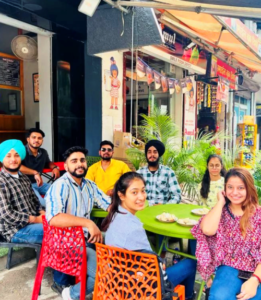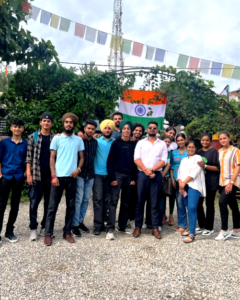Nature works for Nature Work PLA
A A dozen years ago, scientists at Cargill got the idea of converting lactic acid made from corn into plastic while examining possible new uses for materials produced from corn wet milling processes. In the past, several efforts had been made to develop plastics from lactic acid, but with limited success. Achieving this technological breakthrough didn’t come easily, but in time the efforts did succeed. A fermentation and distillation process using com was designed to create a polymer suitable for a broad variety of applications.
B As an agricultural based firm, Cargill had taken this product as far as it could by 1997. The company needed a partner with access to plastics markets and polymerization capabilities, and began discussions with The Dow Chemical Company. The next step was the formation of the joint venture that created Cargill Dow LLC. Cargill Dow’s product is the world’s first commercially available plastic made from annually renewable resources such as com.
C By applying their unique technology to the processing of natural plant sugars, Cargill Dow has created a more environmentally friendly material that reaches the consumer in clothes, cups, packaging and other products. While Cargill Dow is a stand-alone business, it continues to leverage the agricultural processing, manufacturing and polymer expertise of the two parent companies in order to bring the best possible products to market.
D The basic raw materials for PLA are carbon dioxide and water. Growing plants, like com, take these building blocks from the atmosphere and the soil. They are combined in the plant to make carbohydrates (sucrose and starch) through a process driven by photosynthesis. The process for making Nature Works PLA begins when a renewable resource such as corn is milled, separating starch from the raw material. Unrefined dextrose, in turn, is processed from the starch.
E Cargill Dow turns the unrefined dextrose into lactic acid using a fermentation process similar to that used by beer and wine producers. This is the same lactic acid that is used as a food additive and is found in muscle tissue in the human body. Through a special condensation process, a lactide is formed. This lactide is purified through vacuum distillation and becomes a polymer (the base for NatureWorks PLA) that is ready for use through a solvent-free melt process. Development of this new technology allows the company to “harvest” the carbon that living plants remove from the air through photosynthesis. Carbon is stored in plant starches, which can be broken down into natural plant sugars. The carbon and other elements in these natural sugars are then used to make NatureWorks PLA.
F Nature Works PLA fits all disposal systems and is fully compostable in commercial composting facilities. With the proper infrastructure, products made from this polymer can be recycled back to a monomer and re-used as a polymer. Thus, at the end of its life cycle, a product made from Nature Works PLA can be broken down into its simplest parts so that no sign of it remains.
G PLA is now actively competing with traditional materials in packaging and fiber applications throughout the world; based on the technology’s success and promise, Cargill Dow is quickly becoming a premier player in the polymers market. This new polymer now competes head-on with petroleum-based materials like polyester. A wide range of products that vary in molecular weight and crystallinity can be produced, and the blend of physical properties of PLA makes it suited for a broad range of fiber and packaging applications. Fiber and non-woven applications include clothing, fiberfill, blankets and wipes. Packaging applications include packaging films and food and beverage containers.
H As Nature Works PLA polymers are more oil- and grease-resistant and provide a better flavor and aroma barrier than existing petroleum-based polymers, grocery retailers are increasingly using this packaging for their fresh foods. As companies begin to explore this family of polymers, more potential applications are being identified. For example, PLA possess two properties that are particularly useful for drape fabrics and window furnishings. Their resistance to ultraviolet light is particularly appealing as this reduces the amount of fading in such fabrics, and their refractive index is low, which means fabrics constructed from these polymers can be made with deep colors without requiring large amounts of dye. In addition, sportswear makers have been drawn to the product as it has an inherent ability to take moisture away from the skin and when blended with cotton and wool, the result is garments that are lighter and better at absorbing moisture.
I PLA combines inexpensive large-scale fermentation with chemical processing to produce a value-added polymer product that improves the environment as well. The source material for PLA is a natural sugar found in plants such as com and using such renewable feedstock presents several environmental benefits. As an alternative to traditional petroleum-based polymers, the production of PLA uses 20%-50% less fossil fuel and releases a lower amount of greenhouse gasses than comparable petroleum-based plastic; carbon dioxide in the atmosphere is removed when the feedstock is grown and is returned to the earth when the polymer is degraded. Because the company is using raw materials that can be regenerated year after year, it is both cost-competitive and environmentally responsible.
Questions 1 – 4
Write the letters A-F in boxes 1-4 on your answer sheet.
A. make things like clothes
B. produce plastic from plant
C. selling plastic in market
D. fermentation process
E. drape fabrics
F. wrapping products
1. Scientists manage to
2. Cargill needs to have contacts with
3. Nature work is used for
4. Ingeo is used to
Questions 5 – 8
Complete the following summary of the paragraphs of reading passage. Using NO MORE THAN TWO WORDS from the reading passage for each answer.

Question 9 – 10
Choose the correct letter, A, B, C or D.
9. Why did choose the PLA as material for food packaging?
A It smells good
B It can save food freshness
C It can be used on other materials
D Some other things need to be revised about it.
10. What is PLA packaging is used for?
A absorbing moisture
B composting facilities
C Packaging fresh food
D manufacturing
Questions 11 – 12
Which two features of PLA are correct?
A It is made of renewable raw materials
B It involves the removal of carbon dioxide
C It is no use of fossil fuel product
D It uses renewable raw resources
E It is sustenance which can absorb the CO2 in the atmosphere
Questions 13 – 14
Which two features of PLA are correct?
A It takes in moisture of skin
B It is waterproof
C comfortable sportswear
D It’s fading under the sun
E It is only made in deep color
Renewable Energy
An insight into the progress in renewable energy research
A The race is on for the ultimate goal of renewable energy: electricity production at prices that are competitive with coal-fired power stations, but without coal’s pollution. Some new technologies are aiming to be the first to push coal from its position as Australia’s chief source of electricity.
B At the moment the front-runner in renewable energy is wind technology. According to Peter Bergin of Australian Hydro, one of Australia’s leading wind energy companies, there have been no dramatic changes in windmill design for many years, but the cumulative effects of numerous small improvements have had a major impact on cost. ‘We’re reaping the benefits of 30 years of research in Europe, without have to make the same mistakes that they did,’ Mr Bergin says.
C Electricity can be produced from coal at around 4 cents per kilowatt-hour, but only if the environmental costs are ignored. ‘Australia has the second cheapest electricity in the world, and this makes it difficult for renewable to compete,’ says Richard Hunter of the Australian Ecogeneration Association (AEA). Nevertheless, the AEA reports: ‘The production cost of a kilowatt-hour of wind power is one-fifth of what it was 20 years ago,’ or around 7 cents per kilowatt-hour.
D Australian Hydro has dozens of wind monitoring stations across Australia as part of its aim to become Australia’s pre-eminent renewable energy company. Despite all these developments, wind power remains one of the few forms of alternative energy where Australia is nowhere near the global cutting edge, mostly just replicating European designs.
E While wind may currently lead the way, some consider a number of technologies under development have more potential. In several cases, Australia is at the forefront of global research in the area. Some of them are very site-specific, ensuring that they may never become dominant market players. On the other hand, these newer developments are capable of providing more reliable power, avoiding the major criticism of windmills – the need for back-up on a calm day.
F One such development uses hot, dry rocks. Deep beneath South Australia, radiation from elements contained in granite heats the rocks. Layers of insulating sedimentation raise the temperatures in some location to 250° centigrade. An Australian firm, Geoenergy, is proposing to pump water 3.5 kilometres into the earth, where it will travel through tiny fissures in the granite, heating up as it goes until it escapes as steam through another drilled hole.
G No greenhouse gases are produced, but the system needs some additional features if it is to be environmentally friendly. Dr Prue Chopra, a geophysicist at the Australian National University and one of the founders of Geoenergy, note that the steam will bring with it radon gas, along through a heat exchanger and then sent back underground for another cycle. Technically speaking, hot dry rocks are not a renewable source of energy. However, the Australian source is so large it could supply the entire country’s needs for thousands of years at current rates of consumption.
H Two other proposals for very different ways to harness sun and wind energy have surfaced recently. Progress continues with Australian company EnviroPower’s plans for Australia’s first solar chimney near Mildura, in Victoria. Under this scheme, a tall tower will draw hot air from a greenhouse built to cover the surrounding 5 km². As the air rises, it will drive a turbine* to produce electricity. The solar tower combines three very old technologies – the chimney, the turbine and the greenhouse – to produce something quite new. It is this reliance on proven engineering principles that led Enviropower’s CEO, Richard Davies, to state: There is no doubt this technology will work, none at all.’
I This year, Enviropower recognized that the quality of sunlight in the Mildura district will require a substantially larger collecting area than was previously thought. However, spokesperson kay Firth says that a new location closer to Mildura will enable Enviropower to balance the increased costs with extra revenue. Besides saving in transmission costs, the new site ‘will mean increased revenue from tourism and use of power for telecommunications. We’ll also be able to use the outer 500 metres for agribusiness.’ Wind speeds closer to the tower will be too high for farming.
J Another Australian company, Wavetech, is achieving success with ways of harvesting the energy in waves. Wavetech’s invention uses a curved surface to push waves into a chamber, where the flowing water column pushes air back and forth through a turbine. Wavetech was created when Dr Tim Devine offered the idea to the world leader in wave generator manufacturers, who rather surprisingly rejected it. Dr Devine responded by establishing Wavetech and making a number of other improvements to generator design. Wavetech claims that, at appropriate sites, ‘the cost of electricity produced with our technology should be below 4 cents per kilowatt-hour.
K The diversity of forms of greenhouse – friendly energy under development in Australia is remarkable. However, support on a national level is disappointing. According to Richard Hunter of the AEA, ‘Australia has huge potential for wind, sun and wave technology. We should really be at the forefront, but the reality is we are a long way behind.’
Questions 15 – 21
Do the following statements agree with the information given in reading passage? In boxes 15-26 on your answer sheet, write
TRUE if the statement agrees with the information
FALSE if the statement contradicts the information
NOT GIVEN if there is no information on this
15. In Australia, alternative energies are less expensive than conventional electricity.
16. Geoenergy needs to adapt its system to make it less harmful to the environment.
17. Dr Prue Chopra has studied the effects of radon gas on the environment.
18. Hot, dry rocks could provide enough power for the whole of Australia.
19. The new Enviropower facility will keep tourists away.
20. Wavetech was established when its founders were turned down by another company.
21. According to AEA, Australia is a world leader in developing renewable energy.
Questions 22-27
Look at the following statements (Questions 8-13) and the list of companies below. Match each statement with the correct company, A-D.
22. During the process, harmful substances are prevented from escaping.
23. Water is used to force air through a special device.
24. Techniques used by other countries are being copied.
25. The system can provide services other than energy production.
26. It is planned to force water deep under the ground.
27. Original estimates for part of the project have been revised.
How Fair is Fair Trade?
The fair-trade movement began in Europe in earnest in the post-war period, but only in the last 25 years has it grown to include producers and consumers in over 60 countries.
In the 1950s and 60s, many people in the developed world felt passionately about the enormous disparities between developed and developing countries, and they believed the system of international trade shut out African, Asian, and South American producers who could not compete with multinational companies or who came from states that, for political reasons, were not trading with the West. The catchphrase ‘Trade Not Aid’ was used by church groups and trade unions – early supporters of fair trade – who also considered that international aid was either a pittance or a covert form of subjugation. These days, much fair trade does include aid: developed-world volunteers offer their services, and there is free training for producers and their workers.
Tea, coffee, cocoa, cotton, flowers, handicrafts, and gold are all major fair-trade items, with coffee being the most recognisable, fund on supermarket shelves and at café chains throughout the developed world.
Although around two million farmers and workers produce fair-trade items, this is a tiny number in relation to total global trade. Still, fair-trade advocates maintain that the system has positively impacted upon many more people worldwide, while the critics claim that if those two million returned to the mainstream trading system, they would receive higher prices for their goods or labour.
Fair trade is supposed to be a trade that is fair to producers. Its basic tenet is that developed-world consumers will pay slightly more for end products in the knowledge that developing-world producers have been equitably remunerated, and that the products have been made in decent circumstances. Additionally, the fair-trade system differs from that of the open market because there is a minimum price paid for goods, which may be higher than that of the open market. Secondly, a small premium, earmarked for community development, is added in good years; for example, coffee co-operatives in South America frequently receive an additional 25c per kilogram. Lastly, purchasers of fair-trade products may assist with crop pre-financing or with the training of producers and workers, which could take the form of improving product quality, using environmentally friendly fertilisers, or raising literacy. Research has shown that non-fair-trade farmers copy some fair-trade farming practices, and, occasionally, encourage social progress. In exchange for ethical purchase and other assistance, fair-trade producers agree not to use child or slave labour, to adhere to the United Nations Charter on Human Rights, to provide safe workplaces, and to protect the environment despite these not being legally binding in their own countries. However, few non-fair-trade farmers have adopted these practices, viewing them as little more than rich-world conceits.
So that consumers know which products are made under fair-trade conditions, goods are labelled, and, these days, a single European and American umbrella organisation supervises labelling, standardisation, and inspection.
While fair trade is increasing, the system is far from perfect. First and foremost, there are expenses involved in becoming a fair-trade-certified producer, meaning the desperately poor rarely participate, so the very farmers fair-trade advocates originally hoped to support are excluded. Secondly, because conforming to the standards of fair-trade certification is costly, some producers deliberately mislabel their goods. The fair-trade monitoring process is patchy, and unfortunately, around 12% of fair-trade-labelled produce is nothing of the kind. Next, a crop may genuinely be produced under fair-trade conditions, but due to a lack of demand cannot be sold as fair trade, so goes onto the open market, where prices are mostly lower. It is estimated that only between 18-37% of fair-trade output is actually sold as fair trade. Sadly, there is little reliable research on the real relationship between costs incurred and revenue for fair-trade farmers, although empirical evidence suggests that many never realise a profit. Partly, reporting from producers is inadequate, and ways of determining profit may not include credit, harvesting, transport, or processing. Sometimes, the price paid to fair-trade producers is lower than that of the open market, so while a crop may be sold, elsewhere it could have earnt more, or where there are profits, they are often taken by the corporate firms that buy the goods and sell them on to retailers.
There are problems with the developed-world part of the equation too. People who volunteer to work for fair-trade concerns may do so believing they are assisting farmers and communities, whereas their labour serves to enrich middlemen and retailers. Companies involved in West African cocoa production have been criticised for this. In the developed world, the right to use a fair-trade logo is also expensive for packers and retailers, and sometimes a substantial amount of the money received from sale is ploughed back into marketing. In richer parts of the developed world, notably in London, packers and retailers charge high prices for fair-trade products. Consumers imagine they are paying so much because more money is returned to producers when profit-taking by retailers or packers is a more likely scenario. One UK café chain is known to have passed on 1.6% of the extra 18% is charged for fair-trade coffee to producers. However, this happens with other items at the supermarket or cafe, so perhaps consumers are naive to believe fair-traders behave otherwise. In addition, there are struggling farmers in rich countries, too, so some critics think fair-trade associations should certify them. Other critics find the entire fair-trade system flawed – nothing more than a colossal marketing scam- and they would rather assist the genuinely poor in more transparent ways, but this criticism may be overblown since fair trade has endured for and been praised in the developing world itself.
Questions 28-32
Answer the questions below. Choose NO MORE THAN THREE WORDS from the passage for each answer
28. What was an early slogan about addressing the imbalance between the developed and developing worlds?
29. What is probably the most well-known fair-trade commodity?
30. According to the writer, in terms of total global trade, what do fair-trade producers represent?
31. How do its supporters think fair trade has affected many people?
32. What do its critics think fair-trade producers would get if they went back to mainstream trade?
Questions 33-36
Complete each sentence with the correct ending, A-H, below. Write the correct letter A-H, in boxes 33-36 on your answer sheet.
A. loans or training for producers and employees.
B. although they may not be obliged to do so in their own country
C. for the various social benefits fair trade brings.
D. to pay more for what they see as ethical products.
E. has influenced non-fair-trade producers.
F. because these are United Nations obligations.
G. too much corruption.
H. have been adopted by non-fair-trade producers.
33. Consumers of fair-trade products are happy
34. The fair-trade system may include
35. Some fair-trade practices
36. Fair-trade producers must adopt international employment standards
Questions 37-40
Do the following statements agree with the claims of the writer in reading passage? In boxes 37-40 on your answer sheet, write:
YES if the statement agrees with the views of the writer
NO if the statement contradicts the views of the writer
NOT GIVEN if it is impossible to say what the writer thinks about this
37. The fair-trade system assists farmers who are extremely poor.
38. Some products labelled as fair-trade is in fact not.
39. UK supermarkets and cafes should not charge such high prices for fair-trade items.
40. Fair trade is mainly a marketing ploy and not a valid way of helping the poor.








